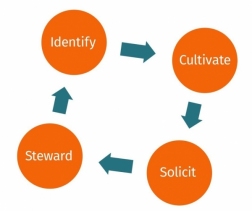October 17, 2019
The True Meaning of Stewardship

“Stewardship” is a word we hear often in the church, especially beginning at this time of year and ending before Advent. What we in the Episcopal Church often mean when we say “stewardship” is the annual pledge drive conducted each fall, which is designed to secure financial commitments from members to fund the following year’s mission and ministry.
While I was raised in the Episcopal Church hearing this language, and while I still slip into using it myself with clients and in my own church, I’m here to ask that we please change our ways. In the secular nonprofit world, where I received my fund development education and first ten years of professional experience, the word “stewardship” does not connote asking for money; asking for money is “solicitation.”
“Stewardship” is everything the fund development team—either volunteer or staff—does to build the relationship with the giver after they have given but before they are asked again. Stewarding your givers is taking care of them and giving to them when you do not need anything from them.
Let’s shift our habits and parlance to use stewardship in its proper way and call our pledge drives what they are: the annual fund campaign or the annual pledge drive.
The Fundraising Cycle

So, how do you do “stewardship” right? Here are some ideas for how to steward your pledgers in the other three seasons of the year:
- Thank You Notes – A handwritten note from clergy, vestry, stewardship committee members, or ministry leaders will go a long way to making a positive impression on your giver. To be clear, this is different from the mailed acknowledgment or quarterly giving statement.
- Pledger Lists – Consider publishing pledger lists in your bulletins, newsletters, annual reports to acknowledge and thank givers. You can sort by giving level or not, depending upon the culture of your congregation.
- Social Media – Platforms like Facebook and Instagram are the most likely to reach the adults who are pledging in your congregation. Posting clever images and captions are quick, fun ways to thank donors. An example: post an image of an empty coffee cup with the caption “Thanks to all of our 2019 pledgers, we have enjoyed fellowship over 5,000 cups of coffee this year!”
- Tokens of Gratitude – Relevant tokens of gratitude and celebration can remind people why they give. Pass out coffee mugs with your church logo, thanking everyone for making coffee hour possible each Sunday, or pass out Peppermint Patties, thanking everyone for keeping the air conditioning working this summer. This does not have to be expensive to have an impact.
- Financial Updates – Share regular updates about the congregation’s financial status in the bulletin, newsletter, online, or on a bulletin board. Keeping givers informed about the congregation’s financial standing shows them that you are using their gifts in appropriate ways to God’s glory, which instills confidence in your leadership and makes it easier for givers to give again when asked.
- Ministry updates – Communicate about the accomplishments and impact of ministries funded by the annual budget. Share statistics for membership growth, worship attendance, parish life events, community engagement and outreach programs, etc. Tell a story about how dollars given to the annual budget have allowed your congregation to be the hands and feet of God in this world.
These are just a few ideas. Get creative! Have fun! The Stewardship Committee, which is charged with year-round work to both steward donors and put in place the fall annual campaign, can have fun with this!
The original text of this article has been edited to reflect ECF's current programs.





